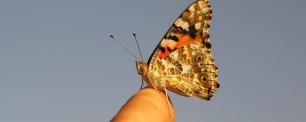Excessive vegetation in Arabia generated massive migrations of butterflies in 2019 through Europe and Africa
For much of 2019, Europe was filled with migrating butterflies. Specifically, millions of Vanessa cardui butterflies (the Vanessa of the thistles), generating an extraordinary natural spectacle that impacted the collective memory of many countries. Now, science has managed to decipher the origin of this population explosion and how these butterflies spread across several continents. The research, in which CREAF participates, has been led by researchers from the Barcelona Botanical Institute (IBB, CSIC-CMCNB), a joint center of the Higher Council for Scientific Research and the Barcelona Natural Sciences Museum Consortium, in collaboration with other entities.
The study analyzed the DNA of the pollen particles that hundreds of butterflies carried on their bodies, to 10 different countries and for 7 months of 2019.
The study analyzed the DNA of large amounts of pollen that hundreds of butterflies carried on their bodies, to 10 different countries and for 7 months of 2019. Using massive sequencing or metabarcoding techniques, the researchers identified the pollen of up to 398 different plant species, many of which were not found where the butterflies were collected and were, in fact, native to distant regions. By studying the distributions of these plants, they identified the origins and routes of the butterflies. The detection of endemic plants from the Middle East revealed the original focus of migrations in this region. This finding coincided, at the same time, with hundreds of observations by citizens who described clouds of migratory butterflies from the eastern Mediterranean to eastern Europe.
Satellite images to chart migrations
To understand the possible mechanisms that led to a massive explosion of millions of butterflies, the researchers used satellite images. In the words of Roger López-Mañas, main co-author of the article, pre-doc researcher at IBB-CSIC and UAB and doctoral student of Cristina Domingo (CREAF), Gerard Talavera (IBB, CSIC-CMCNB) and Clément Bataille (University of Ottawa) . Roger's research focuses on the migrations of insects, especially butterflies, from the field of remote sensing, an essential tool to monitor the growth of vegetation and help understand migratory movements. “Analyses of satellite images taken over the last 20 years allowed us to detect that vegetation growth levels at the beginning of 2019 were exceptionally high in the Middle East, covering large areas of desert in green. "The butterflies must have taken advantage of this anomaly to lay eggs on these plants: they arrived at the right place at the right time." This work has been part of Roger's doctorate, who continues to do research on the migrations of insects, especially butterflies, from the field of remote sensing.

“After the butterfly boom of 2019, we thought that the adults had to have found a place with exceptionally favorable conditions to be able to lay eggs. First, we identified plant species through the pollen they carried and studied their distribution. From this, we made models of plant distribution to look at where they were, compared them to the growth of vegetation from satellite images and saw that it fit".
CRISTINA DOMINGO, CREAF and UAB researcher and co-author of the study.

The thistle vanessa migrates annually through several successive generations, completing migratory cycles between tropical Africa and Europe up to 15,000 km away. The population explosion of 2019 had a cascading effect that was noted throughout Europe. In May, mass migrations were already observed in Scandinavia and Russia, and at the end of June, they were noticeable as they passed through the United Kingdom and the Pyrenees. Pollen analyzes showed that butterflies collected in Scandinavia had visited typically Mediterranean or Eastern European plants, while those collected in the Iberian Peninsula showed pollen from Northern Europe. With this data, and through statistical and ecological modeling techniques, the researchers were able to generate probabilistic maps of the routes that different generations took across the continent.
Ecological importance
Tracking the migratory movements of organisms as small as insects involves great technical difficulty. However, these have great ecological importance as pollinators, for the transfer of biomass to the soil, as food for other species, as possible agricultural or forestry pests, or as possible transmitters of parasites. However, these movements usually go unnoticed, and there are no established protocols to systematically monitor them.
Insect demographic explosions that occur in one site can have consequences in other regions and times, due to possible migration.
This discovery exemplifies the potential impact that insect migrations can have, involving ecological processes across very broad regions, and even several continents. “Our results demonstrate the interconnectivity between our borders and ecosystems. The demographic explosions of insects that occur in one place can have consequences in other regions and times, due to possible migration,” explains Gerard Talavera, leader of the study.
The work also highlights the importance of citizen science, that is, the contributions of hundreds of observers from many countries who recorded their findings on digital platforms. These data, analyzed together, corroborated the researchers' results obtained through pollen analyses.
Reference article: Gorki JL, López-Mañas R, Sáez L, Menchetti M, Shapoval N, Andersen A, Benyamini D, Daniels S, García-Berro A, Reich MS, Scalercio S, Toro-Delgado E, Bataille CP, Domingo-Marimon C, Vila R, Suchan T, Talavera G. (2024). Pollen metabarcoding reveals the origin and multigenerational migratory pathway of an intercontinental-scale butterfly outbreak. Current Biology. https://www.sciencedirect.com/science/article/abs/pii/S0960982224006808






